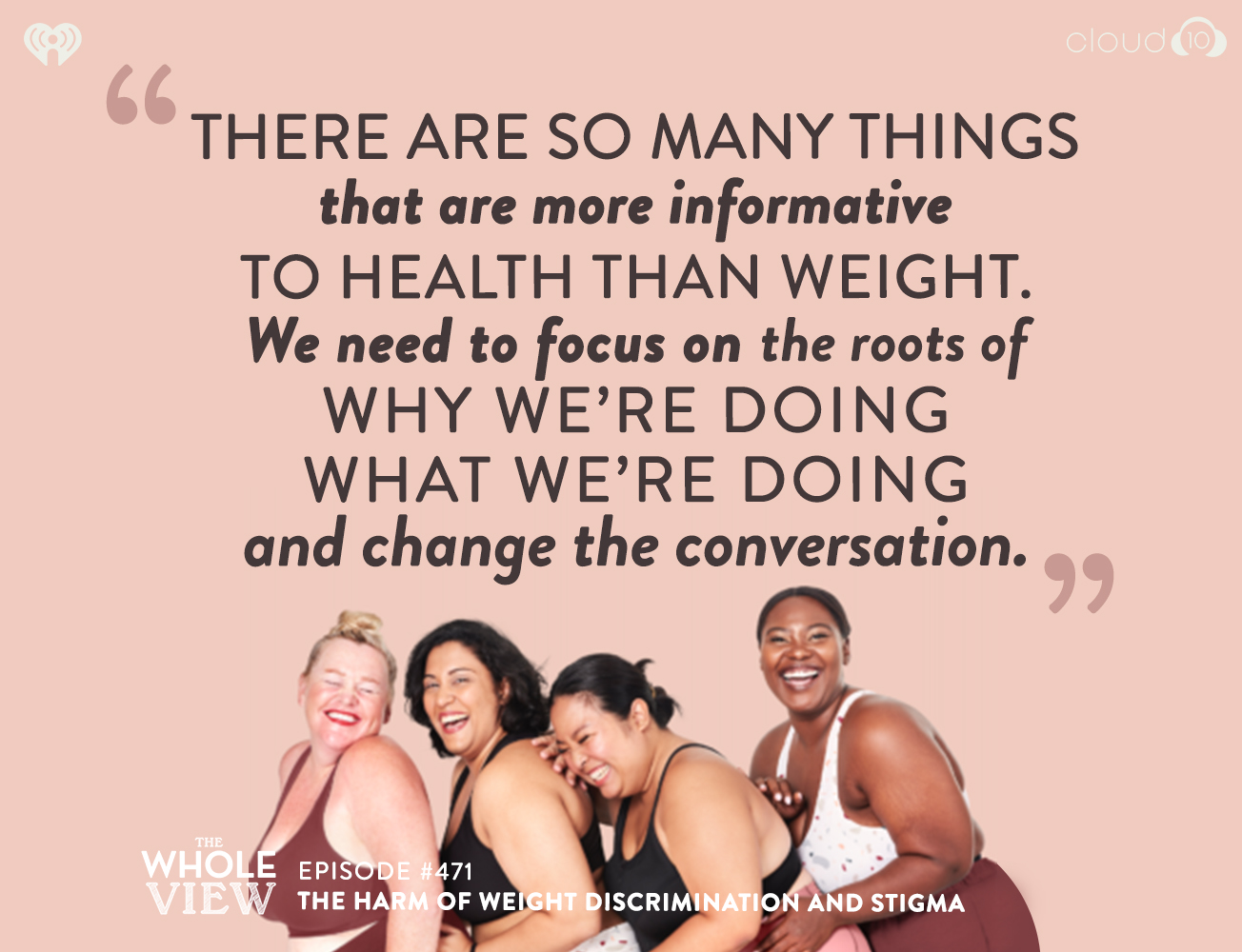
Welcome to episode 472 of The Whole View! This week, Stacy and Dr. Sarah dive into the science behind weight discrimination and stigma in this continuation of last week’s show. They look at studies around how discrimination plays into stress, medical discrimination, and the body positive movement.
If you enjoy the show, please review it on iTunes!
The Whole View, Episode 472: The Harm of Weight Discrimination and Stigma – Part 2
Welcome back to episode 472! (0:28)
This is part 2 of Stacy and Dr. Sarah’s show on weight discrimination and stigma. Get caught up on part one here!
Now, a quick recap from last week:
Weight is a very poor indicator of health! Many overweight and obese people are very healthy and many thin people are not.
Overweight and obesity are not the risk factor for obesity-related diseases. They are instead a symptom of an underlying health challenge, like chronic stress, gut dysbiosis, hypothyroidism or insulin resistance. It can also indicate poor health-related behaviors, like sedentary lifestyle or poor diet quality.
Overweight BMI associates with the lowest mortality rate, drawing into question whether or not we even placed the goalpost correctly.
Losing weight does not automatically make you healthier!
And the body fights hard against weight loss, which is why 77% of people gain back all the weight within 5 years.
Weight Stigma Is SUPER Harmful to Health
Obesity is often blamed for metabolic syndrome due to a combination of risk factors including insulin resistance, inflammation, hypertension, elevated serum lipids. (8:02)
However, a variety of studies show that it’s weight discrimination and weight stigma behind the increased risk of type 2 diabetes and cardiovascular disease. It also lowers life expectancy.
An important 2011 study of over 900 non-diabetic adults examined how weight discrimination affected blood sugar regulation, relative to BMI, waist-to-hip ratio, and waist circumference.
Weight discrimination was assessed by asking the participants how often on a day-to-day basis (from never to often) they experienced:
- less courtesy than other people
- less respect than other people
- poorer service than other people at restaurants or stores
- people acting as if they think you are not smart and/or dishonest
- eople acting as if they are afraid of you or better than you
- called names or insults
- feeling threatened or harassed
Similar questionnaires assessed perceived discrimination in the following studies.
Researchers assessed blood sugar regulation of hemoglobin A1C (HbA1C), which is a good indicator of average blood glucose levels over the previous 2 to 3 months.
More Evidence On Weight Stigma
High HbA1C [above 6.5%] is indicative of type 2 diabetes. And a recent study showed that, for every 1% increase in HbA1C above 7%, diabetic patients experienced a 21% increased risk for any cardiovascular disease event.
Patients experienced a 37% increased risk of dying from cardiovascular disease.
While researchers did link higher BMI, waist-to-hip ratio, and waist circumference to elevated HbA1C, the study showed that weight discrimination exaggerated the increase. This was independent of other health behaviors like smoking, exercise, and fast food consumption as well as other covariates like age, race, and gender.
Weight discrimination increased average blood glucose levels (indicative of insulin resistance) independent of exercise.
People with high waist-to-hip ratios and who experienced weight discrimination had the highest HbA1C levels in the study!
This is particularly interesting when you consider that high levels of chronic stress are strongly associated with increased waist-to-hip ratios (due to cortisol’s impact on abdominal fat deposition, see for example this study).
Also, stress reduces insulin sensitivity, which Stacy and Sarah just talked about in TWV Podcast Episode 469: Insulin Sensitivity vs. Lifestyle
A 2014 study of over 7,000 participants showed that weight discrimination is also inflammatory. Similar to the previous study, participants filled out a questionnaire to gauge their experiences with weight discrimination and researchers assessed systemic inflammation by serum C-reactive protein (CRP).
While CRP did increase proportionally with BMI, participants who experienced weight discrimination had exaggerated CRP levels relative to BMI. The exception is with those with class III obesity (BMI > 40) where CRP was similarlyelevated whether they experienced weight discrimination or not.
Even More Evidence On Weight Stigma
Another 2014 study in 45 healthy overweight to obese women showed that experiencing weight discrimination elevated oxidative stress, as measured by F2-isoprostanes, even after controlling for covariates including income, education, and global perceived stress.
One thing that was really interesting about this study is that they assessed both exposure to and consciousness of weight stigma using a questionnaire that asked participants about 50 specific weight-stigmatizing situations.
Weight stigma is harmful to our health, even when we’re not aware of it.
A 2017 study of nearly 27,000 adults evaluated the link between cardiovascular disease and perceived weight, gender, and racial discrimination in the USA.
Participants who experienced weight discrimination had a 2.56X higher likelihood of myocardial infarction and a 1.48X higher likelihood of minor heart conditions, after accounting for BMI, smoking, alcohol consumption, major depressive disorder, stressful life events, age, sex, income, education, and race/ethnicity.
(Racial discrimination but not gender discrimination also increased risk of myocardial infarction and minor heart conditions, in addition to additionally increasing risk of arteriosclerosis).
As you might expect, individuals who experienced multiple forms of discrimination had the highest risks of cardiovascular disease in this study.
A 2015 analysis of two different datasets (the Participants in the Health and Retirement Study, which included over 13,000 participants, and the Midlife in the United States Study associated weight discrimination with a nearly 60% increased mortality risk.
This is even after accounting for age, sex, race/ethnicity, education, BMI, subjective health, disease burden, smoking history, depressive symptoms, and physical activity!
This study also found that, in general, mortality risk increases more in association with weight discrimination than for other forms of discrimination.
Why Is Weight Stigma So Harmful? Stress!
One very clever2012 study of 99 young women who perceived themselves as overweight clearly demonstrated the stress response related to weight stigma. (37:05)
The study participants gave a recorded speech. Some were told that an audience would view the recording on video while others would listen to the audio only.
Throughout the speech, blood pressure was continuously monitored—mean arterial pressure is well-known to elevate in response to stress.
Not only was mean arterial pressure higher among women who believed they were being video-taped compared to those giving what they believed to be an audio-taped speech, but the effect increased with BMI.
Basically, the higher the BMI, the more self-conscious the women were about judgement and the higher their stress response.
A2016 study of 28 healthy young women (half normal-weight and half obese) evaluated heart rate variability in response to monetary and social incentive delay tasks.
This was relative to experienced weight discrimination assessed with a series of questionnaires.
Women with obesity had lower HRV when experiencing negative social outcomes compared with normal-weight women. This was in women who had experienced weight-related teasing.
And a2014 study showed that the experience of weight stigma, as assessed by questionnaires, significantly increased morning salivary cortisol, the cortisol awakening response and serum cortisol measured from fasting morning blood samples.
More Evidence on Effects of Weight Stigma
For example, in another2014 study, participants were shown a 10-minute video containing weight-based stigmatizing scenarios or a neutral video.
It shown the weight-based stigmatizing scenario video exhibited sustained cortisol reactivity, independent of their bodyweight.
A2017 study of almost 1000 participants showed that individuals who experienced weight discrimination had more than double the risk of having a high allostatic load.
A high allostatic load is the cumulative maladaptation of multiple physiological systems (i.e., cardiovascular, sympathetic/parasympathetic nervous, HPA axis, immune, and metabolic) in response to chronic stressors.
This was after accounting for covariates, including age, race/ethnicity, household income, education, smoking status, and physical activity.
And, those who experienced long-term discrimination (at least a decade) had a 3.36X increased risk of high allostatic load.
Stacy’s Take
Stacy is not surprised that being discriminated against causes stress!
She also thinks it’s important to remind listeners that chronic stress increases the risk of depression and anxiety, cardiovascular disease, obesity, diabetes, autoimmune diseases, chronic headaches, memory problems, digestive problems, and infections and is linked with poor wound healing.
For more on this, check out TWV episodes:
- Stress on Health
- Nutrient Deficiencies Caused by Stress
- Practical Tips for the Sleep Stress Cycle
- How to Break the Stress-Flare-Antibiotic Cycle
Experts believe these effects are mediated by the activation of the hypothalamic-pituitary-adrenal axis (HPA axis) and the impact that cortisol and other adrenal hormones have on immune function.
Weight Stigma Drives the Obesity Epidemic
A common perception is fat-shaming (whether framed positively or negatively, and whether by a well-meaning friend or your doctor) encourages overweight individuals to lose weight. But it actually has the opposite effect.
As summarized in a2018 review article, experiencing weight stigma triggers behavioral changes linked to poor metabolic health and weight gain. It includes overeating, smoking, excessive alcohol consumption, and exercise avoidance.
A2017 study showed that, when overweight and obese people experienced weight stigma at their gyms, they developed negative attitudes toward the gym, maladaptive coping behaviors, weight bias internalization, unhealthy weight control practices, and lower self-reported physical and emotional health.
Here’s the kicker- all that was regardless of how frequently they went to the gym.
Why?
The combination of chronic psychosocial stress along with maladaptive behavioral changes in response to weight stigma results in a substantially increased risk of becoming and remaining obese.
A2017 study showed that weight-based teasing of adolescents (average age was 15) predicted higher BMI and obesity in adulthood after a 15-year follow-up.
On top of that, weight-based teasing during adolescence also increased risk of binge eating, chronic dieting, eating as a coping strategy, unhealthy weight control, and poor body image.
Interestingly, this study striated by whether the teasing occurred from peers, from family members or from both.
It found that, for women, teasing from family members increased risk of obesity more than teasing from peers (2.58X compared to 1.84X). For men, teasing from peers but not family increased risk (2.44X).
A2013 study of over 6,000 participants aged 50 and over in the USA, showed that individuals who experienced weight discrimination had a 2.54X higher likelihood of becoming obese if they weren’t at baseline.
They also had a 3.2X higher likelihood of remaining obese if they were at baseline, at a 4-year follow-up. This effect was independent of age, sex, race/ethnicity, education, baseline BMI, and other forms of discrimination.
A2014 study of nearly 3,000 people over the age of 50 in the United Kingdom similarly showed that weight discrimination increased risk of weight gain and increased waist circumference.
This was with a whopping 6.67X increased risk of becoming obese at a 4 year follow-up. But there is no increased risk of remaining obese for those who were at baseline).
Medical Descrimination Is Harmful, too
Studies now show that medical discrimination against overweight and obese people is a major problem. (59:00)
A 2017 analysis paints a disconcerting picture that aligns with our experiences.
When overweight and obese people go to the doctor, they’re likely to have their symptoms attributed to their weight, without diagnostics being performed. Instead, they are counseled (with more than a sprinkling of fat-shaming micro-aggressions) to lose weight.
These common experiences lead overweight patients to delay seeking healthcare in order to avoid the stress of interacting with disrespectful and dismissive providers.
The combination of assumptions by healthcare providers and hesitancy to seek medical care by overweight individuals leads to less preventative medicine than normal-weight individuals, as well as higher levels of undiagnosed or misdiagnosed health conditions.
For example, a 2006 study of more than 300 autopsy reports found a 1.65X increased likelihood of obese patients, relative to normal-weight patients, having a significant undiagnosed medical condition . These conditions include endocarditis, ischemic bowel, lung carcinoma.
They also often experience misdiagnosis or inadequate healthcare that may have contributed to their death.
It’s not that obesity increased the risk of these medical conditions, but rather that it increased the risk of dying from them due to inadequate healthcare.
Health at Any & Every Size
A 2011 review article calls this way of thinking a “weight-inclusive approach.” It emphasizes viewing health and wellbeing as multifaceted while directing efforts toward improving health access and reducing weight stigma. (1:05:05)
Doing so rests on the assumption that everybody is capable of achieving health and wellbeing independent of weight, given access to nonstigmatizing health care.
The 2008 study described in detail above shows that overweight and obese people absolutely can be metabolically healthy.
The following studies show that obese people who aren’t metabolically healthy can measurably improve their health… without losing weight.
Better yet, this weight-inclusive approach to health (also called weight neutral) shows lasting physical and mental health benefits when weight-loss centric approaches fall short.
A 2005 study in 78 obese women, aged 30 to 45 and who were chronic dieters, evaluated the efficacy of a program created by Dr. Lindo Bacon called “Health at Every Size” compared to a typical behavior-based weight-loss program for one year, with follow-up at two years.
The principles of the Health at Every Size program are:
-
- “Accepting and respecting the diversity of body shapes and sizes.”
- Promoting eating in a manner which balances individual nutritional needs, hunger, satiety, appetite, and pleasure.
- Recognizing that health and well-being are multidimensional and that they include physical, social, spiritual, occupational, emotional, and intellectual aspects.
- Promoting individually appropriate, enjoyable, life-enhancing physical activity, rather than exercise that is focused on a goal of weight loss.
- Promoting all aspects of health and well-being for people of all sizes.”
Even though the women in the typical behavior-based weight-loss program group lost an average of 5.2 kilograms (about 11.5 pounds), they didn’t see improvements in serum lipids or blood pressure.
Fighting Weight Stigma
The Health at Every Size group, on the other hand, did not lose weight but had significant improvements in total serum cholesterol, LDL “bad” cholesterol and blood pressure (systolic and diastolic)!
They also had reduced hunger and disinhibition (loss of control that follows violation of self-imposed rules), and an improved score in an eating disorder evaluation.
Even better, 100% of the women in the Health at Every Size group had improved self-esteem, whereas the women in the traditional diet group had decreased self-esteem (53% of them expressed feelings of failure compared to 0% in the Health at Every Size group).
These health improvements were maintained at two years for the Health at Every Size group, but the traditional diet group regained most of the lost weight by the two-year mark.
A 2009 study in 144 premenopausal overweight and obese women compared the Health at Every Size program to a social support group (small-group counseling facilitated by a registered dietitian and clinical psychologist) and a control group (instructed to follow their usual lifestyle habits) for a 4-month intervention period and a 16-month follow-up period.
While the Health at Every Size group did lose an average of 2% of their bodyweight, the primary advantages were decreased susceptibility to situational eating, disinhibition, and hunger.
Stacy’s Take
So, this is NOT saying that we should (and you know how Stacy feels about that word) give up, do or eat whatever we want, or stop caring.
We did a whole show on why we don’t think that the idea of intuitive eating that is spread throughout the body positivity is a good idea in Episode 358: How Intuitive Eating Has It Wrong
Instead, science supports dissociating the desire to lose weight from the intention to improve health.
It also re-emphasizes the incredible health benefits we can experience with a nutrient-dense anti-inflammatory diet, active lifestyle, managed stress, and sufficient sleep.
The backlash of this confounds Stacy and only proves the point. She’s shared her concerns with the disregard for factors of listening to our bodies with intuitive eating.
If we think it’s the responsibility of someone of size to only show health promoting things what life are they living? She genuinely doesn’t think people stop and think about that.
She does think it’s why her weight and the negative mental effects of it got to her for so long.
Sarah’s Body Positive Journey With Weight Stigma
Dr. Sarah realized while doing this research that she hadn’t done all the emotional work that she needed to do (1:20:30)
A resource she found really helpful was a recent TED talk by Connie Sobczak, one of the founders of bodypositive.org.
She found she could take pride in every good choice she made throughout the day. And there was so many more opportunities to feel good about her health behaviors outside weight loss.
She also finally really did put away my scale
She feels like such a newbie because she was so steeped for so long. And being called out by people she liked to consider peers for the harm she did earlier on definitely still sits with her.
Stacy’s Body Positive Journey With Weight Stigma
Stacy thinks that being open about the research and personal journeys will provide a platform needed to heal and help others learn. (1:26:05)
She shared before that changing your social media to remove anyone that triggers negative feelings (of self especially)- needs to be muted or unfriended. She’s completely changed her circle of influence to help herself change and grow.
As someone with a background in disordered eating, she loves the work of Jameela Jamil. She’s amazing at summarizing and responding to a lot of what’s happening in popular culture.
She found great follows in her i_weigh community.
Stacy also HIGHLY recommends Dr. Josh, who is a medical professional (since we aren’t ones) who shares his perspective with facts and truths and tips for people looking to prioritize health not weight.
Final Thoughts
We invite you to subscribe to this channel and the realeverything.com and thepaleomom.com blogs and newsletters.
If you haven’t joined the Patreon family yet, head over for exclusive behind-the-scenes content about how Stacy and Sarah feel about the topics they discuss. Your subscription goes to support this show and gets you direct access to Stacy and Sarah.
Thank you so much for listening, and we’ll see you next week for part 2 of weight discrimination and stigma!
Want more info on our Real Life? Healthy recipes, parenting tips, and general lifestyle stuff goes out in our Real Everything newsletter, join here.
Never want to miss a post, sale, or deal? Join my Healthy Inside & Out e-mail list for more info on non-toxic living and safer skincare!





